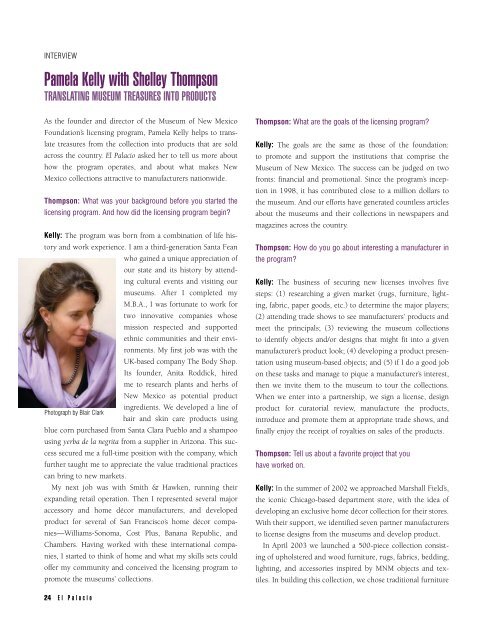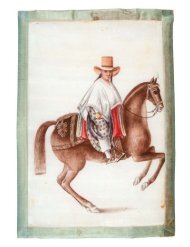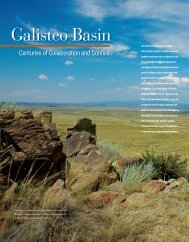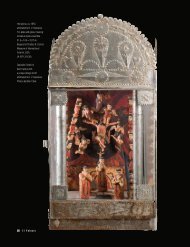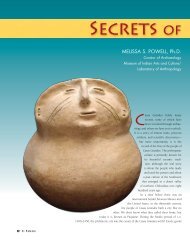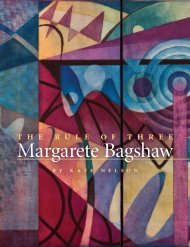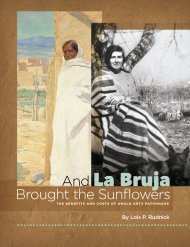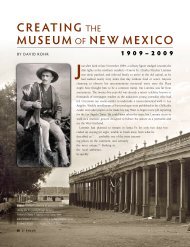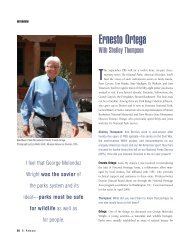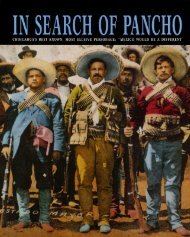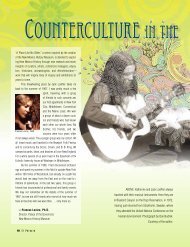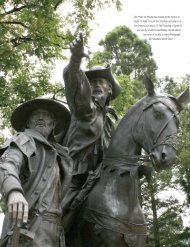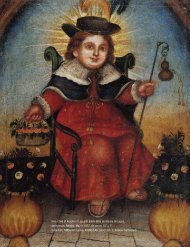Pamela Kelly with Shelley Thompson - El Palacio Magazine
Pamela Kelly with Shelley Thompson - El Palacio Magazine
Pamela Kelly with Shelley Thompson - El Palacio Magazine
Create successful ePaper yourself
Turn your PDF publications into a flip-book with our unique Google optimized e-Paper software.
INTERVIEW<br />
<strong>Pamela</strong> <strong>Kelly</strong> <strong>with</strong> <strong>Shelley</strong> <strong>Thompson</strong><br />
Translating Museum Treasures into Products<br />
As the founder and director of the Museum of New Mexico<br />
Foundation’s licensing program, <strong>Pamela</strong> <strong>Kelly</strong> helps to translate<br />
treasures from the collection into products that are sold<br />
across the country. <strong>El</strong> <strong>Palacio</strong> asked her to tell us more about<br />
how the program operates, and about what makes New<br />
Mexico collections attractive to manufacturers nationwide.<br />
<strong>Thompson</strong>: What was your background before you started the<br />
licensing program. And how did the licensing program begin<br />
<strong>Kelly</strong>: The program was born from a combination of life history<br />
and work experience. I am a third-generation Santa Fean<br />
who gained a unique appreciation of<br />
our state and its history by attending<br />
cultural events and visiting our<br />
museums. After I completed my<br />
M.B.A., I was fortunate to work for<br />
two innovative companies whose<br />
mission respected and supported<br />
ethnic communities and their environments.<br />
My first job was <strong>with</strong> the<br />
UK-based company The Body Shop.<br />
Its founder, Anita Roddick, hired<br />
me to research plants and herbs of<br />
New Mexico as potential product<br />
ingredients. We developed a line of<br />
Photograph by Blair Clark<br />
hair and skin care products using<br />
blue corn purchased from Santa Clara Pueblo and a shampoo<br />
using yerba de la negrita from a supplier in Arizona. This success<br />
secured me a full-time position <strong>with</strong> the company, which<br />
further taught me to appreciate the value traditional practices<br />
can bring to new markets.<br />
My next job was <strong>with</strong> Smith & Hawken, running their<br />
expanding retail operation. Then I represented several major<br />
accessory and home décor manufacturers, and developed<br />
product for several of San Francisco’s home décor companies—Williams-Sonoma,<br />
Cost Plus, Banana Republic, and<br />
Chambers. Having worked <strong>with</strong> these international companies,<br />
I started to think of home and what my skills sets could<br />
offer my community and conceived the licensing program to<br />
promote the museums’ collections.<br />
<strong>Thompson</strong>: What are the goals of the licensing program<br />
<strong>Kelly</strong>: The goals are the same as those of the foundation:<br />
to promote and support the institutions that comprise the<br />
Museum of New Mexico. The success can be judged on two<br />
fronts: financial and promotional. Since the program’s inception<br />
in 1998, it has contributed close to a million dollars to<br />
the museum. And our efforts have generated countless articles<br />
about the museums and their collections in newspapers and<br />
magazines across the country.<br />
<strong>Thompson</strong>: How do you go about interesting a manufacturer in<br />
the program<br />
<strong>Kelly</strong>: The business of securing new licenses involves five<br />
steps: (1) researching a given market (rugs, furniture, lighting,<br />
fabric, paper goods, etc.) to determine the major players;<br />
(2) attending trade shows to see manufacturers’ products and<br />
meet the principals; (3) reviewing the museum collections<br />
to identify objects and/or designs that might fit into a given<br />
manufacturer’s product look; (4) developing a product presentation<br />
using museum-based objects; and (5) if I do a good job<br />
on these tasks and manage to pique a manufacturer’s interest,<br />
then we invite them to the museum to tour the collections.<br />
When we enter into a partnership, we sign a license, design<br />
product for curatorial review, manufacture the products,<br />
introduce and promote them at appropriate trade shows, and<br />
finally enjoy the receipt of royalties on sales of the products.<br />
<strong>Thompson</strong>: Tell us about a favorite project that you<br />
have worked on.<br />
<strong>Kelly</strong>: In the summer of 2002 we approached Marshall Field’s,<br />
the iconic Chicago-based department store, <strong>with</strong> the idea of<br />
developing an exclusive home décor collection for their stores.<br />
With their support, we identified seven partner manufacturers<br />
to license designs from the museums and develop product.<br />
In April 2003 we launched a 500-piece collection consisting<br />
of upholstered and wood furniture, rugs, fabrics, bedding,<br />
lighting, and accessories inspired by MNM objects and textiles.<br />
In building this collection, we chose traditional furniture<br />
24 <strong>El</strong> <strong>Palacio</strong>
Living room (Shonnard Chair in foreground),<br />
Traditions Made Modern® Showroom, April 2004,<br />
photograph by John Hall.<br />
pieces and updated them for a modern audience. We also<br />
did what comes naturally to New Mexicans: we layered on<br />
ethnic influences through textiles, accent furniture pieces,<br />
and decorative accessories. Traditions Made Modern®—the<br />
name we chose to market the products under—was a huge<br />
success, generating significant revenues and great publicity<br />
for the museum.<br />
The two best-selling pieces were the Manderfield Bed<br />
and the Shonnard Chair, named for their original owners.<br />
Philadelphia-born William Manderfield traveled west on the<br />
Santa Fe Trail <strong>with</strong> the ornate Victorian bed strapped to his<br />
covered wagon. Eugenie Shonnard, the New York–born, Paristrained<br />
sculptress, came to New Mexico in the late 1920s and<br />
brought <strong>with</strong> her some wonderful European furniture.<br />
<strong>Thompson</strong>: What is the value of the MNM brand and how does<br />
the licensing program contribute to and/or support our brand<br />
attributes<br />
<strong>Kelly</strong>: Branding is as critical to the program’s success as the<br />
quality of products we offer. People need to know that what<br />
you offer is both unique and of quality. The challenge and<br />
pleasure I have <strong>with</strong> our licensing program is that we actually<br />
have five brands: the Museum of New Mexico and the<br />
four individual museums. As such, depending on my targeted<br />
licensee, I will promote one or all.<br />
<strong>Thompson</strong>: How do New Mexico’s unique history and culture<br />
make a program like this possible<br />
<strong>Kelly</strong>: Despite what some in the general public might believe,<br />
New Mexico has never been solely about cowboys, Indians,<br />
and outlaws. It has also been about explorers, artists, and traders<br />
who brought cultural and design influences from Europe,<br />
Spain, Mexico, Latin America, and Asia into this place of<br />
beautiful landscapes and interesting Native communities. As<br />
a result, New Mexico has long stood at the crossroads of culture,<br />
creating and defining yet a new aesthetic paradigm that<br />
mixes the Old World <strong>with</strong> the New World. It’s a very appealing<br />
concept to modern designers and retail establishments who<br />
respond to consumers’ desire to bring meaning, beauty, and<br />
continuity into their homes.<br />
Today, as people across the country have become more<br />
casual and nomadic, moving and living in more than one city,<br />
design rules have relaxed, and furniture design and interior<br />
decoration have shifted from the “suited collection” of pieces<br />
that match, to a new trend, one focused more on how people<br />
actually live. Many people inherit a nice family piece or two<br />
and over time add other pieces bought at antique stores or<br />
on trips, or that round out a collection. The result is a more<br />
eclectic home. New Mexicans long ago perfected that eclectic<br />
look. I trace this effortless style and confidence to the historic<br />
trade routes that crisscrossed New Mexico (Native trade in and<br />
around Chaco, the Camino Real, Santa Fe Trail, the AT&SF<br />
Railroad, and even Route 66), delivering goods from around<br />
the world that residents here simply added to Native and<br />
Spanish traditional pieces.<br />
<strong>Thompson</strong>: How did the Old World and the New come together<br />
in New Mexico to create a unique style<br />
<strong>Kelly</strong>: New Mexico’s unique style is a blending of European<br />
style and Native design motifs translated initially <strong>with</strong> relatively<br />
simple tools. The result: a beguiling, rustic interpretation<br />
of European design mixed and melded <strong>with</strong> traditional<br />
Native American motifs. Trade goods delivered to Santa Fe<br />
from Mexico on the Camino Real were highly refined and representative<br />
of European, Mexican, and Asian design traditions.<br />
Native design was equally refined and elegant, but manifested<br />
itself in a more spare and highly graphic manner. Because this<br />
combination of design traditions was initially interpreted or<br />
made real by artisans using relatively simple tools, a whole<br />
new style emerged—one rooted in a European design tradition,<br />
translated through Native eyes, and/or made manifest by<br />
local artisans.
INTERVIEW<br />
<strong>Thompson</strong>: Why do our collections appeal to manufacturers<br />
What do they come here to find<br />
<strong>Kelly</strong>: West of the Mississippi, the collections of the four<br />
museums are unrivaled in the breadth and depth of their<br />
offerings. The 23,000-piece textile collection at the Museum<br />
of International Folk Art is considered one of the top ten ethnic<br />
collections in the world. The Museum of Indian Arts &<br />
Culture’s Native textile, ceramic, and basketry collections offer<br />
a wealth of bold and graphic pattern inspiration to contemporary<br />
designers. Countless museums and books feature historic<br />
English or French furniture, but very few feature the unique<br />
blend of European, Mexican, and Native design found in the<br />
furniture collections at the New Mexico History Museum and<br />
MOIFA. Our furniture licensees find inspiration not just in<br />
the overall silhouette of a piece, but also in the hardware, the<br />
manner of construction, or the patina of aged wood.<br />
A storyboard from the design process shows the “Yucca” fabric from the<br />
Shelter collection by Designtex <strong>with</strong> the Pima baskets from MIAC that inspired it.<br />
Photograph courtesy of Designtex.<br />
<strong>Kelly</strong>: Contemporary design is about clean lines, bold graphics,<br />
and elegant simplicity. Interestingly, our best resource of<br />
such design is found at MIAC in the basketry, textile, and<br />
ceramic collections. Several manufacturers/licensees have<br />
developed beautiful contemporary objects from MIAC pieces.<br />
Nambé developed a series of leaded glass vases and metal<br />
alloy platters inspired by Pueblo pottery and basketry.<br />
Designtex—a textile and wall-covering manufacturer selling<br />
to the commercial market—developed a gorgeous and sophisticated<br />
collection called Shelter. And West <strong>El</strong>m—a division<br />
of Williams-Sonoma that sells furniture, rugs, lighting, and<br />
bedding—has developed a series of contemporary wool rugs<br />
inspired by basketry and textile designs at MIAC.<br />
Nambé Lead Crystal Vase, photograph courtesy of Nambé.<br />
<strong>Thompson</strong>: Many museums sell reproductions of objects in their<br />
collections, but that is not the focus of your program. Why not<br />
<strong>Kelly</strong>: MNM represents the art, culture, and history of the state,<br />
and many of the objects in our collections represent living and<br />
thriving traditions. Out of respect for the fact that so many<br />
New Mexicans still make their living creating and selling work<br />
based upon these traditions, we do not sell reproductions. The<br />
shop buyers can get the “real thing” from local artists.<br />
<strong>Thompson</strong>: Is there some object or collection that you just adore<br />
and keep hoping a manufacturer will fall in love <strong>with</strong>, though the<br />
match has not yet been made<br />
<strong>Kelly</strong>: The ethnic dress collection at MOIFA is fantastic. My<br />
dream would be to partner <strong>with</strong> a haute couture designer to<br />
develop a fashion collection. Can’t you just see it Models<br />
of all races walking down a Paris runway, wearing stunning<br />
fashions inspired by clothing from Palestine, Macedonia,<br />
Guatemala, India, and New Mexico It’s just one dimension of<br />
what we have to offer, and why I continue to love my job. The<br />
opportunities are endless. n<br />
<strong>Thompson</strong>: How do our collections provide inspiration for products<br />
that appeal to contemporary buyers<br />
<strong>Shelley</strong> <strong>Thompson</strong> is the director of marketing and outreach for the<br />
Museum Resources Division of the New Mexico Department of Cultural Affairs.<br />
She interviewed Nicolasa Chávez for the winter 2012 issue of <strong>El</strong> <strong>Palacio</strong>.


